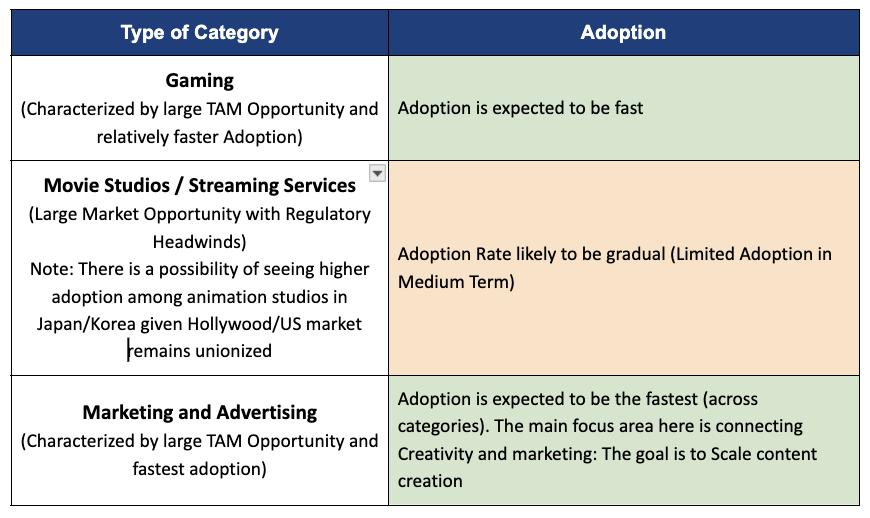
At Lightspeed India, we are excited about the potential impact of widespread adoption of AI technologies. We spoke with leaders from scaled AI infrastructure providers to understand where they expect the significant spending on foundational models to originate from.
OpenAI has recently surpassed US$1.6 billion in annualized revenue, according to an article published in The Information. This represents an increase from US$1.3 billion as of mid-October. Anthropic, financially backed by Google and Amazon, has projected that it will generate over US$850 million in annualized revenue by the end of 2024. Similarly, there are other scaled companies such as Midjourney that are generating annualized revenues of over US$200 million.
Below is the scale of select AI companies based on the Generative AI Database maintained by The Information (publicly available)

During our conversations, we came across some intriguing themes that we will delve into in detail
Vertical-based enterprise software use cases with heavy documentation needs are likely to have higher adoption compared to large horizontal software use cases. Key focus areas include BFSI, Healthcare, and Legal-based use cases. In terms of spending on AI compute and inference, Content and Media is expected to be the largest category. The three key areas with significant impact are gaming, marketing and advertising (including social media), and long-form content (with a specific focus on animation). Foundation model companies also believe that LLMs can help pharmaceutical companies speed up drug development. LLMs can analyze both structured and unstructured/textual data from clinical trials for better understanding of drug efficacy and safety. Lastly, many IT services with moderately complex workflows are likely to experience significant adoption of AI workloads.
The Key Areas where Foundation Model Spends are likely going to accrue
Processing Healthcare Data
Eroom’s law states that the inflation adjusted cost of developing a new drug tends to double approximately every 9 years. Drug discovery is also one of the most expensive areas of healthcare, with per unit costs increasing significantly.
While the pharmaceutical industry has taken various measures to improve the success rate of new therapeutic modalities, the percentage of revenue allocated to research and development (R&D) has significantly risen. This is largely due to the lengthy process involved in determining the effectiveness of a drug. Understanding the biology and the intricate interactions of the drug with different systems increases the level of complexity.

There is another interesting trend in healthcare regarding the collection of health data. While devices like Peloton, Apple Watch, and others have been used to gather significant amounts of consumer healthcare data, there has been little effort to analyze and interpret it. The lack of analytical infrastructure hinders the ability to provide real-time insights into patient medical history and biological signals, such as heart rate, oxygen levels, and others.
A significant portion of the EHR data, which includes patient information, doctors’ notes, and diagnostic data like lab results, microbiology, and imaging, remains underutilized. Despite the high penetration of Electronic Health Records (EHR) in the US (95% in 2014 from 10% in 2008), there has been limited extraction of insights from the data, whether at the individual patient level or across large datasets.
Large foundation model companies anticipate that LLMs can assist pharmaceutical companies in expediting drug development. This can be achieved by extracting more insights from existing clinical trials and consumer health data, as well as enhancing the design of new trials through a more comprehensive understanding of prior evidence. Pharma companies can analyze both numerical and non-numerical/textual data from past and ongoing clinical trials to gain a deeper understanding of drug efficacy and safety. LLMs can facilitate the matching and longitudinal analysis of patient data across multiple clinical trials, allowing for the identification of trends that may be overlooked by traditional isolated approaches. This has the potential to improve success rates in late-stage Phase 3 trials by optimizing trial design based on insights from previous studies.
IT Services Automation: Cost Savings and Productivity Optimization
The foundation model companies are witnessing a significant amount of spending by large services companies around workloads that either involve the combination of large volumes of data and simple tasks or involve the combination of moderate volumes of data and moderately complex tasks.
Additionally, as AI improves efficiency, businesses can shift from charging based on time and manpower to charging based on results. Some of the most important workloads that will be primarily automated include call centre operations, sales agent assistance, and customer support assistance. For example, providing agents with real-time suggestions and likely responses to customer queries based on the conversation context can improve handling speed and customer satisfaction. Automating simple, repeatable inquiries can reduce agent workload. Analyzing large volumes of call data can help identify trends, pain points, and opportunities to improve FAQs, knowledge bases, and training. Moderately complex workflow based AI solutions are likely to see significant adoption. This is also reflected in the statement by ServiceNow in its latest quarterly earnings.
“In Q4, our gen AI products drove the largest net new ACV contribution for our first full quarter of any of our new product family releases ever, including our original Pro SKU.”
One of the interesting statements articulating the reason for net new expansion is as follows:
“The consumer will pay a lot more if they can get a same-day repairs agreement along with the appliance. And the margins on same-day repair are far greater than the box itself, plus you create a nice annuity stream. So what we’re talking about here is fundamentally rethinking the way business is transformed using our platform and gen AI.”
Based on this observation, in India, we have partnered with companies that are creating AI augmented managed labour marketplaces. One of the key examples is Gushwork that successfully attracted high NPS from customers due to their faster turnaround times and high-quality outputs.
Content Media and AI
Content Media is likely to see the highest spend across all categories. The three key areas that are likely to experience significant impact are gaming, marketing and advertising (including social media), and long-form content, with a particular focus on animation. Three key themes are likely expected to drive the spends
- Localization: Content localization for audiences (languages, characters, tone, others – i.e. scaling more culturally relevant content). For eg. Amazon Prime is localizing one movie in 35-45 languages (Budget – US$3-4M per movie).
- Asset Creation: Streamlining the process of Asset (characters, visual assets, Background Music, Others) creation
- Hyper-Personalization: Mass production of hyper-personalized content (especially for advertising based use cases / short-form content on social media)

Gaming
- Asset creation: 3D game assets like characters, vehicles, weapons etc. This can reduce the time and costs involved in manual asset creation
- Level/Environment design: Tools that use AI to quickly prototype levels/environments based on design inputs can boost the pre-production process
- Localization: AI translation models can help localize game text, audio and UI to multiple languages automatically, reducing localization costs
- Dynamic gameplay: AI agents powered by ML can create unpredictable and life-like non-player characters (NPCs) with personalized dialogue trees. This enhances immersion and replayability. Lightspeed has invested in Inworld in this category
- Sound/Design/Music for games – AI-assisted sound design and creation of audio assets like character voices, and sound effects for video games. Additionally, create adaptive background scores and music for games based on gameplay events in real-time
- Pre-production tasks like brainstorming ideas, designing characters/environments, and writing dialogue/scripts.
Marketing and Advertising
- Hyper Personalized (Content) Targeting: AI tools for generating large volumes of Personalized images, videos, and texts for digital ads and social posts with minimal human effort. This is P0 for Social Media Companies (and is likely to be super compute intensive)
- Dynamic creative optimization: Real-time optimization of creative elements like images, copy, placements to maximize engagement
- Overall automation of Ad based Workflows – focussing right from creation to advertisement placement. All Social Media companies are building in this space
Long-form Content / Animation
- Localization: For eg. supplementing the voice by enabling any actor’s voice to be transferred to characters. Key immediate use cases include bringing the content that is produced for audiences in Italy, Spain, or Korea for English audiences (specially in the Documentary genre). However, significant efforts need to be made to iron out business models in relation to licensing actors’ voices.
- Enhancing visual effects and CGI capabilities by training generative models on specific studios’ styles. This allows mass-producing high-quality background scenes and environments for movies
- Sound/design/Music for Movies: AI-assisted creation of audio assets/background music
- Streamlining pre-production processes like brainstorming, scriptwriting, storyboarding and character/environment design
Knowledge Assistance for Vertical Use Cases – Documentation Heavy Tasks
The initial wave of significant adoption of Generative AI in 2023 primarily occurred among (Tech 1st) large horizontal software companies. These companies swiftly incorporated thin AI wrappers or plugins into their existing applications to introduce basic generative capabilities. Many of these projects were experimental in nature. Some of the key projects implemented focused on enhancing user productivity by adding search functions, automatically generating content (e.g., for sales and marketing purposes), and conducting preliminary analysis of unstructured data. However, it is anticipated that the spending on Foundation Models for this category will stabilize.
Foundation Model vendors expect that AI is likely to play a significant role in building specialized knowledge graphs for professionals in domains where complex knowledge, voluminous data, and data synthesis are required. The key verticals that are likely to see significant high growth in LLM spending are expected to be – BFSI, Legal, and Healthcare. Examples of workloads include – legal contract review, insurance underwriting, loan underwriting, and others. For example, Goldman Sachs’ expenditure on Microsoft cloud products remained relatively stable in the first half of the year (2023), but increased by over 20% in the second half. This increase is partly attributed to Goldman’s development of AI models that analyze data, such as corporate earnings reports, to support the bank’s investment choices. Additionally, the bank increased its spending on GitHub Copilot, allocating up to US$1.2 million annually for its ~10,000 software developers.
Lightspeed in the US has partnered with EvenUp, an AI powered legal software platform that augments personal injury lawyers by automatically generating demand letters and a comprehensive data repository for all settlement cases. With EvenUp, attorneys see immediate value in preparing demand letters faster, with more detail and accuracy of backup information, and for less cost than the equivalent amount of manual human work. Typically, injured parties are represented by attorneys who negotiate claims on their behalf against large insurance carriers by filling a demand letter. This demand letter is the key document which presents facts to reach an adequate compensation amount for the client. Given Plaintiff attorneys, who rarely use software, have very limited access to data, they in most cases underestimate the demand compensation when going against defense attorneys of large insurance firms who have access to all sorts of sophisticated software and databases. EvenUp not only automates the process of preparing demand letters faster, with more detail and accuracy of backup information, and for less cost than the equivalent amount of manual human work but it also offers a corpus of recent settlement data by aggregating public and private cases, allowing attorneys to generate demand letters with a ~30%-100% increase in settlement value when compared to similar past cases. Lightspeed has also published a detailed thesis around Legal x AI here.
If any of you are building in these zip codes, feel free to reach out to us.
Dev Khare and Prateek Raj
Authors





